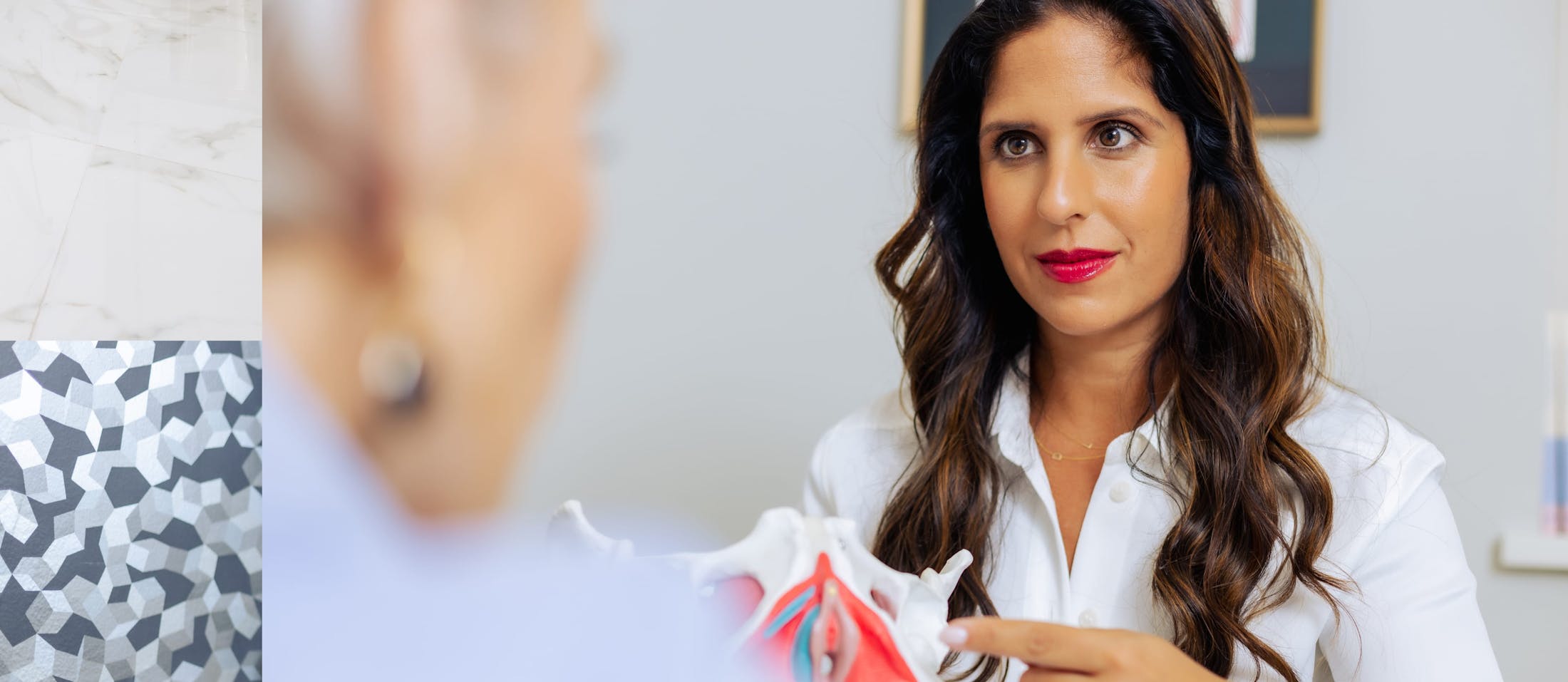
We know how worrisome it can be when pain interferes with your sex life. We at Pelvic Pain Doc are here to have honest conversations about your sexual health, so let’s get straight to it. If you’re experiencing stabbing clitoris pain or a sudden burning, stinging or itchy sensation, it could be “clytoridinia,” also known as clitoral pain.
But let’s make sure we’re on the same page first. What is the clitoris? You ask. You know it’s part of sexual functioning but what does it do? And where is it exactly? Simply put, the clitoris is the pleasure center of your vulva. It contains 8,000 nerve endings, making it highly sensitive to touch. You’ll find your clitoris where your inner labia meet at the top and form a cover over the clitoris (called the clitoral hood). Touching, stroking and stimulating the clitoris bring about sexual arousal and orgasm. However, if the clitoris hurts, you instead feel confusion and frustration.
Thankfully, clitoral pain is easily identifiable and treatable by your pelvic pain specialist. More than likely, you’ll soon be on your way to a pleasurable sex life again. Here, Dr. Sonia Bahlani covers what you need to know about clitoral pain. We’ll talk about:
Symptoms of clitorial painTypical causes of clitoral painHow to alleviate the painPracticing preventative care for your clitoris and vulva
Symptoms of Clitoris Pain
Symptoms and severity of clitorial pain vary from person to person, but what is common for everyone is how disruptive it is. As mentioned earlier, pain in the clitoris can feel incredibly sharp, but it can also feel mildly uncomfortable. It can happen infrequently or remain persistent. The pain can intensify if the clitoris or vulva is touched, you move a certain way, or when you’re wearing tight underwear or clothing. You might also see a bump on the clitoris or have swelling. If any of these symptoms sound like what you’re experiencing, we encourage you to book an appointment with us at our New York office.
Causes of Clitoral Pain
Treating clitoral pain requires first determining what’s contributing to it. As with any pain, the cause could be an issue with the clitoris itself or referred pain from elsewhere on the vulva. Clitoral pain can also have more than one cause. As a pelvic pain specialist, Dr. Bahlani can identify the cause(s) of your clitorial pain and help you get back to feeling like you.
Typical causes of clitoral pain are:
Keratin Pearls: Keratin pearls are the buildup and hardening of your clitoris’ glandular secretions into a grain-like substance. These secretions adhere your clitoris and clitoral hood together. Ordinarily, the clitoral hood should roll back freely when the clitoris is aroused, so when it can’t, you can suffer from pain and inflammation. This is one of the most common clitoral pain conditions.
Dermatological Conditions: Sharp pain in the clitoris is sometimes a symptom of skin infections or diseases such as:
Lichen sclerosus – Patchy, white blotches on the skin resulting in itching or discomfort. The exact cause is unknown, though hormonal imbalances and an overactive immune system play a part. Lichen planus -This dermatological infection looks like a rash of pink-purple bumps.
Allergic reactions – The ingredients in everyday products — laundry detergent, soaps, lotions, douches or sexual products — can cause contact dermatitis and a swollen, more sensitive clitoris. Eczema and psoriasis – Though typically associated with other areas of the body, eczema and psoriasis are known to show up on the vulva.
Underlying Health Conditions Associated With Clitoral Pain:
Clitoral pain can indicate a bigger pelvic issue. If you’ve had any of these conditions before or are suffering from them currently, be sure to mention them to your pelvic pain specialist:
Vaginal yeast infectionsSexually transmitted diseasesPolycystic ovary syndrome (PCOS)Hypertonic pelvic floor muscle dysfunctionUterine fibroidsUTIsPersistent genital arousal disorder (PGAD)
Less likely, a painful clitoris could relate to issues like cancer, hormonal imbalance, multiple sclerosis or a herniated disc.
Physical Trauma:
Physical trauma of any kind can be difficult to talk about, especially when it relates to pelvic pain, and for some women, their physical trauma is related to their clitoral pain. If this is you, Dr. Bahlani wants you to know that at Pelvic Pain Doc, we’re here to have these conversations for the better — whether good, bad, easy or difficult.
Examples of pelvic trauma include:
Vaginal childbirthPelvic surgeryOveruse or overaggressive use of vibrators and sex toysOveraggressive sexual activitySexual abuse
Alleviating Clitoris Pain
Now that you know the common clitoral pain conditions, you may be asking, “How do I get back to a normal, pleasurable sex life? Or even just a pain-free day-to-day?” Here are the treatments Dr. Bahlani may suggest:
Operation for Keratin Pearls – Typical treatment is either an in-office or operating room procedure that releases the adhesion keratin pearls have caused, then removes the keratin pearls themselves. Mild, post-operative discomfort is normal but it’s a welcome trade off to stabbing clitorial pain.
Topical Treatment for Dermatological Conditions – Skin conditions causing clitorial pain can be alleviated with creams or at-home treatments. We suggest you stop using the detergents, hygiene or sex products that are causing your clitoris pain and we can help you find alternatives. Try lessening or pausing sexual activity while treating your clitoral pain. If these don’t work, Dr. Bahlani has more treatment options that are right for you.
Underlying Health Conditions – Accurate diagnosis of an underlying health condition can only come from your health practitioner. Do you have other health symptoms? See your GP, gynecologist or a pelvic pain specialist.
Physical Trauma – If your clitoris hurts from physical trauma, Dr. Bahlani may suggest at-home treatments such as hot or cold pads and over-the-counter pain relief. You can also try decreasing your sexual activity or practicing gentler sex for a time. If needed, we always encourage therapy or counseling in concert with physical treatment.
Practicing Preventative Care for Your Clitoris
It’s always better to prevent pain if possible, but we know that even when we do our best, sometimes health issues and conditions that cause clitoral pain can still arise. A good start is booking an appointment to see Dr. Bahlani. At home, we suggest cleaning your vulva regularly and becoming familiar with your pelvic region. Dr. Bahlani can provide ways to modify your sexual health choices or help you reassess your overall health and well-being.
Dr. Bahlani is Here to Help
Pelvic Pain Doc is all about open, honest conversations about pelvic pain. Our approach is a holistic, compassionate one and our ultimate goal is to help you spend less time in pain — so you can live your fullest life. If you’re experiencing clitoral or pelvic pain, we invite you to book a virtual consultation or in-person appointment at our Manhattan office today.

